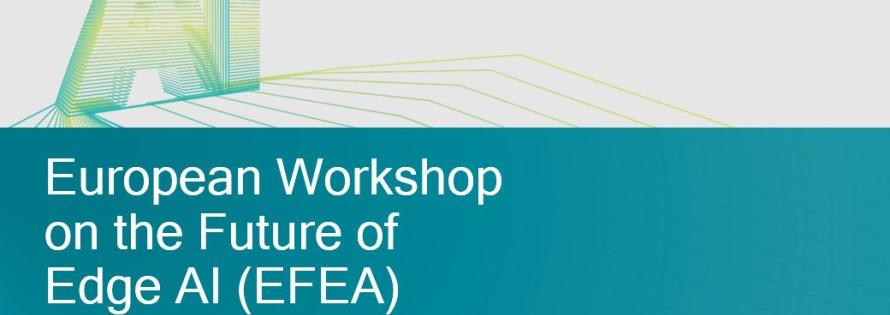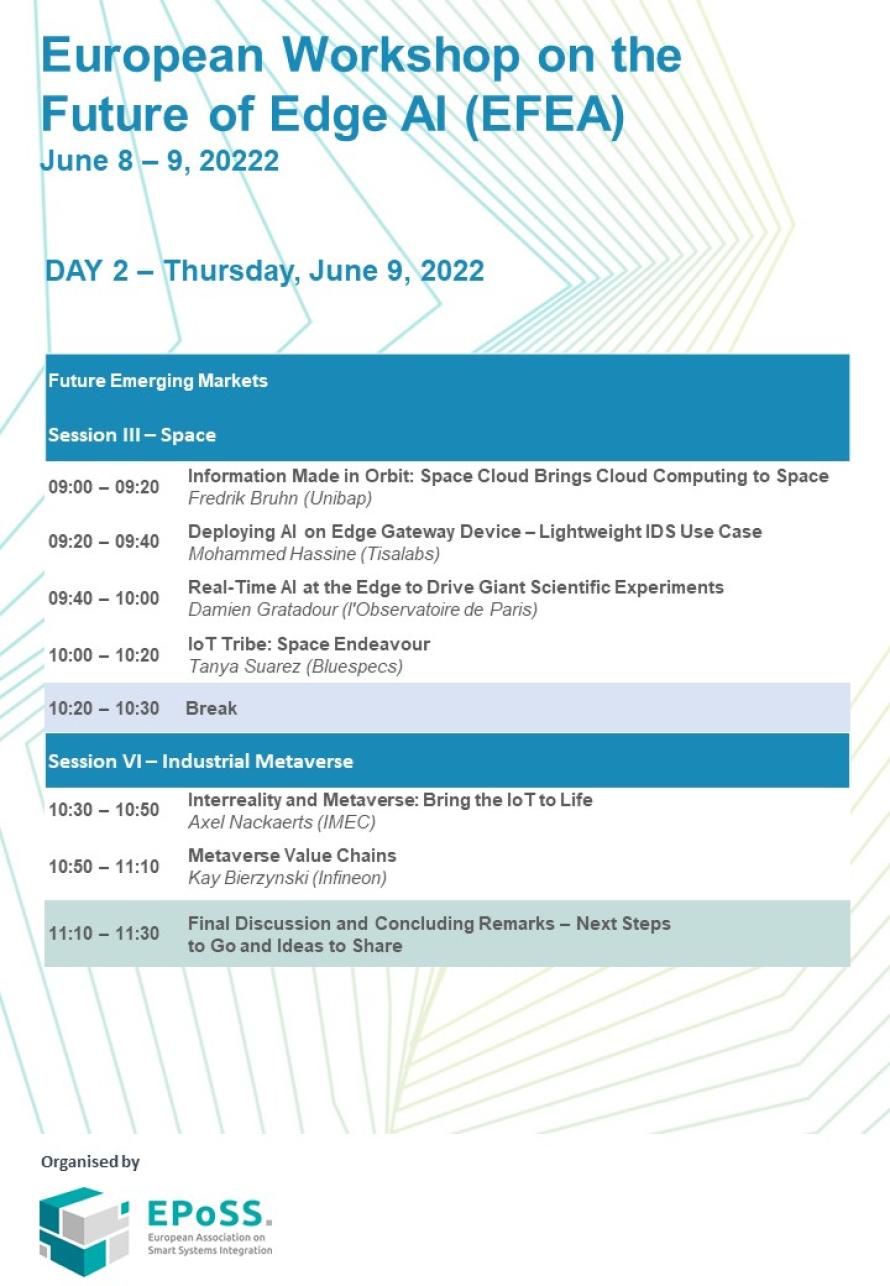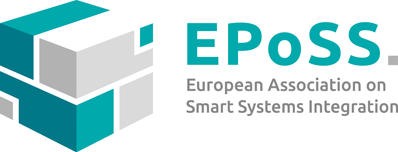
Location
OnlineThe EPoSS Task Force AI at the Edge invited AI experts, system integrators and hardware specialists to the first European Workshop on the Future of Edge AI on June 8-9, 2022.
The workshop addressed the major research and development activities such as hardware AI accelerators, orchestration of edge services and data processing, analog computing, reinforcement learning, explainable, trustworthy, safe and secure edge AI for critical applications, low power systems and emerging markets such as edge AI for space technologies and industrial metaverse.
Please find below the agenda and some of the major statements derived from the discussions.
- Agenda
-


- DAY 1 - Overview about the State of the Art of Edge AI
-
Question of the Day:
What is the future of Edge AI?The discussion revealed come anspects that will contribute to answers this question:
Georgi Kuzmanov, KDT JU:
There is a huge amount of research activities taking place now in the Europe. KDT invites the audience to participate in the KDT calls and to be proactive in the community as well as towards the industry associations.
There is a possibility to shape the Future of Edge AI by contributing to the Electronic Components and Systems (ECS) Strategic Roadmap Agenda (ECS-SRIA) with new concepts and ideas, since it is a way to steer the funding programme and the research and innovation community towards the future.
KDT is listening to the community and expects exciting and innovative proposals and successful Edge AI projects in the next years.
Marc Duranton, CEA:
The key point is to build on a decentralised Edge Computing architecture to avoid centralised data centres that will pull all corporate and private data streams together to one single revenue point.
Edge AI should be energy efficient: Analog computing is a promising approach, yet further approaches to energy efficiency should be taken into consideration. Explainable AI is becoming important. AI might not be that much explainable, at least AI applications should be certifiable: for example taking a taxi you pay no attention to how the brain of a taxi driver works. People rely on her/his certified driving licence. In a similar way, we should rely on AI-based applications and systems.
The main bottleneck for Europe is the concentration of the computing power, data streams and energy in the verticals that are controlled by the big hyperscalors such as google, Amazon, Facebook, Apple, who are working on their own AI chips and solutions. Distributed and fair approach is a solution for the Future of Edge AI in Europe.
Jona Beysens, CSEM:
I think, the future of Edge AI lies in fully distributed systems with indoor and outdoor low-power consuming sensors or devices with energy harvesting capabilities becoming more and more ubiquitous.
The future of Edge AI belongs to fully autonomous systems that communicate with each other using multiple distributed sensor with distributed data processing.
The biggest bottleneck is the missing labelled data. One promising approach in this direction is the reinforcement learning where the smart systems interact with the environment and learn by themselves.
Dr. Djalel Benbouzid, Volkswagen Group:
The question has twisted into “What we would like to see in the future of Edge AI”? The first thing, I would like to see, are reusable software and hardware components that enforce further advancements. Such components contain a pretrained model that could be adapted easily. These models might not be of general purpose but still cover a family of use cases. The components would accelerate the development of new solutions and leverage the pretrained models. In terms of certifiability, I agree with Marc Duranton. We trust the driver licence and the institution that issues. How we test and certify the pretrained and trained AI models is still an open question though.
The second point is the testability of models to deploy and relay on them. Maybe we should see no fully distributed but rather hybrid systems. A part of the data should be processed locally in order to save energy and keep its privacy. Additionally, a centralised system can process the results in order to gain more insights.
We should work on a concept for keeping this centralised data and results private and secure. I argue for hybrid architectures.
Jacek Flak, VTT:
The trends are going towards increasingly intelligent devices: a mobile phone, a sensor network or a car. 20 year ago, we could not even imagine that a smart phone could have so much computing power. This trend will progress regarding the computing and processing approaches. Smart devices will need different hardware accelerators and different optimisation methods. I would take a holistic perspective on the applications and where the data is processed: locally or in a centralised cloud computing environment.
However, it is generally agreed that at least inference should be performed as close to where the data is generated (edge) as possible. We are on a good track pushing the processing towards the edge with many unconventional computing approaches. And there is enough space for both digital and analog technology to complement rather than replace each other.
Bernhard Peischl, AVL:
From the point of view of the automotive sector with increasing clock speed and an increasing amount of sensors it is literally impossible to transfer all the huge amount of data such as time series data into a backend of a remote and centralised cloud computing system. We have to think of approaches to aggregate the data at the edge: near edge, far edge, and find approaches to train this data. The main bottleneck is the availability of data for the third parties.
In the near future, we will think about common European data spaces and data sharing approaches not only on the cloud side but also on the edge side. Data is fuel for any kind of AI and ML models and for the digital economy in particular.
Damien Gratadour, Observatoire de Paris:
The future of edge AI is to strive for sustainability, with the combined goals of being more environmentally friendly, economically viable and having a positive social impact. With the Green Deal, the European Union is already investing on the environmental aspect, together with stronger regulations on a wide range of players from industry to the general public.
With the explosion of edge devices, designers and manufacturers should concentrate on more autonomous devices, i.e equipped with their own renewable energy production capacity through e.g. mini-solar panels or other means fitted to the operating environment. The lifespan of these devices should be long enough to compensate the environmental footprint of their full manufacturing cycle, from the extraction of raw material to their implementation on site. Most importantly, what they do should have some sort of social / societal value. Generating revenue to foster jobs creation is one thing, but it cannot be a goal when it comes at the cost of negative social impact.
AI at the edge has a role to play in all these domains, from micro-managing energy consumption to creating longer lasting / upgradable devices and allowing them to generate more value once implemented. The European Edge AI players should embrace these sustainability goals as opportunities for joint efforts of academia and industry to enable a solid and world leading community.
- DAY 2 - Future Emerging Markets: Space Technologies and Industrial Metaverse
-
Questions of the Day:
What research areas are a good investment for public funding of research and innovation?
In how many years from now: 5, 10 or more, can we expect the return of this investment and which area are the most promising?Fredrik Bruhn, Unibap:
The American companies have been extremely successful in locking in the revenue streams into their apps such as apple app store of google play and transferring the revenue from Europe without paying taxes. It should be a combination of what the government and the industry could do together: We need to create value out of the data and tax it and make profit out of the data. We are now building an European ecosystem in order to extract the information quickly from the data on the orbit and sell and make profit of it. The vision is to create a European space store. In my opinion, the European companies should be extreme good at defining and developing AI and machine learning application that are capable of extracting the information fast and charge for that data.
This is the only way we can get into the revenue stream and create impact. The big European or American companies can disseminate this data for example in the metaverse. But we should generate the value first. That is why there is an accelerator in Sweden which is called Space Edge that is focused on the development of algorithms that extract information and value out of space data.
Question: the European companies are good at assembling and integrating technologies and creating value out of individual customised solutions. What is your opinion on where the European Commission and the national governments should invest?
The European companies are very good in inventing new innovative solutions. However, they are not always best at creating revenues from their innovations. The main point is that many traditional companies, also Ericson, are not a part of the revenue stream of the value chains anymore.
To be a part of the value chain, the companies should focus on the data streams and algorithms for extracting information. Furthermore, we need the same level playing field between European and American companies regarding paying the taxes.
The traditional investment of the Swedish government focuses on the upstream space technologies radars and rockets. The new space strategy makes a shift from upstream to downstream technologies and targets creating value from the space data. Germany and France are now investing more in downstream technologies that open new markets for the new instead of traditional engineering space technologies.
Axel Nackaerts, IMEC:
Smart and interactive things will automatically lead to an optimisation of the highly distributed computing and communication environment. Most of the applications will be distributed. The centralised hyperscalers will not like this development. The operation of their data centres is centralised. The business models of the hyperscalers link the data streams to the data centres. In the future, the highly interactive distributed things will be not efficient at using centralised computing architectures. Instead, distributed infrastructures and data sharing platforms will emerge.
Also, the business models will evolve since multiple users, companies and people will share and charge the computing power where the computing takes place and not as flat rate subscription at a remote data centre in the US. Distributed computing environment will require agreements and standards.
Data exchange standards and distributed systems are crucial for the competiveness of Europe.
Kay Bierzynsky, Infineon:
For the time horizon covering the next five years, the European Union should invest in the solid regulation environment. It is an open issue as to whether Microsoft and Amazon will stay in the next years on the top, there are emerging communities in the blockchain and crypto currency space who could become new players. At the moment these communities are small, but they have a high human capacity potential and many of them have already a high amount of financial resources.
Furthermore, they experimenting with new organisation approaches such as decentralized autonomous organizations (DAO) which have the potential to reduce the problems of existing company structures in regards to flexibility, inclusiveness and profit sharing. Hence, it is very likely that Facebook will not have the whole control over the metaverse.
These new players and communities will push towards the creation of the open metaverse and development of web 3.0. The appropriate regulation framework is a door into the metaverse communities, so that they can grow in Europe. The people who work in the emerging metaverse market will be distributed all over the world. However, the main seeds should be in Europe. This already happens to some degree, because for example the Ethereum Foundation, a non-profit organisation behind the development of one of the most important crypto currencies and technologies called ether, is registered in Switzerland.
Looking at the time horizon of 10 years, manufacturing at the orbit could be a promising scenario for the new markets. Especially for tackling the problems of the climate change, it could be an advantage to move production farms into the orbit.
Furthermore, zero G allows for inventing and using new manufacturing processes for semiconductor production. Development and research around this topic and the exploration and industrialisation of space in general is currently mainly focused in US.
The general idea in the field is that first step would be to improve humanities capabilities to move between the moon, earth orbit and the ground.
Afterwards, a base on the moon should be created for the manufacturing of space ships. Furthermore, the moon base would a good place to serve as the central space port of earth for starting and landing of these ships, because of the lower gravitation forces. From this base the exploration of the rest of the universe could then be started.
Share on
